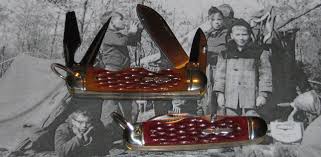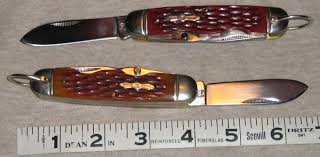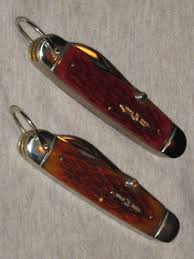
Rough Rider Scout/Utilities

The Scout/Utility
One of my favorite patterns of knives is the Scout/Utility. . It seems as long as there have been bottles or cans needing open, there have been scout knife with a can opener and a cap lifter. And as long as Boy Scouts have been camping, that knife has included a punch (awl) and a spear master blade.
The last U.S. company to produce an Official Boys Scouts of America utility knife was Camillus. Once their doors closed, production of the official knife sold in BSA stores and online was moved overseas to China.
Enough Background on Scout Knives, Lets get to the point and talk about the Rough Rider Scout Knife.
Rough Rider’s Scout knives are a copy of Case pattern 6445* scout knife made during the mid 1900s It featured a spear master blade,punch- style can opener, a large combination cap- lifter/screwdriver and wide awl blade. The pattern has since been discontinued by Case. The Rough Rider Scout is the only current production model of scout knife that features this style of can opener.
(* Case made the 6445 Scout knife with both a punch style can opener and a safety can opener.)
The Blades -- Punch style Can opener (tin Cutter)
As the tin-cutter is the blade that sets this apart from all other current camp knives, I will start by discussing it. The tin cutter or punch style can opener is probably the oldest of the can opener to be made. It consists of triangular shaped blade with one edge being sharpened, and a small guide stud attached to the spine of the blade. In the case of pocket knives, the guide stud also acts as a thumb stud for opening the blade. In order to use the blade, you place it along the lip of a can with the thumb stud facing out, press the tip through the lid of the can until the thumb stud rests on the lip and then leverage the blade back and forth by cutting the lid with the sharpened edge of the blade. This means you are cutting upwards while opening the can.
With practice, you can get very good at it. However, the modern safety can opener is more efficient and safer.. For the most part most knife makers moved on from this punch style can opener in the 1930s. . There are advantages, however, to the punch can opener. The obvious one is that it is a punch, meaning you can more easily use it to punch holes. As the blade is wider and stouter than the punch , it can be used for heavier material, including thin metal without risk of damaging the blade. It can also be used to cut flat sheets of tin or soft metal. My favorite use for the tin cutter is rather mundane. I like to use the blade to open taped boxes. It keeps the gluey residue off my main spear blade and the thumb stud prevents the blade from cutting too deeply into the box.
The Blades -- Spear Master
The spear master blade is 2 ½ inches long which is the standard size for a camp knife. The blade is as thick as those found on old Camillus and Ulster Boy Scout knives; making it thicker than the ones found on other current Camp knives that are offered.. The spear blade is considered the most versatile of all blades. It is good for skinning, good for poking, good for whittling and good for cutting. This blade comes razor sharp out of the box and has holds a good edge. Over time, I have used ceramic sharpening rods and sand paper to return the blade's razor sharp edge.
The Blades -- The Punch
As you can see in the picture, the punch has a very sharp point but gets wider at the tang some other punch blades. It is slightly more than ¼ inch wide at the base. The top is slightly curved and the bottom edge is sharp but not razor sharp. The cutting edge on the punch is 1 5/8 inches. The point is the sharpest of any punch of I’ve ever seen on a scout knife! Unfortunately the this needle like point can also be a problem. The point suffers the same problem found on needle sharp stilettos. It can easily penetrate into very hard surfaces and get stuck, which in turn can lead to the tip bending or breaking when you try to remove it. In short, the awl is not a wood drill. If you need to poke a hole in a very dense surface, you may find the tip breaking. It will be fine for softer wood or leather. If you use your punch frequently for starting holes in hard wood, as I do, you'll probably find yourself re-profiling the tip of the punch. I have done this to one of my Rough Rider camp knives.
The Blades-- Caplifter / Screwdriver
So as not to make you think I forgot about it, the can opener /screwdriver are what you would expect from a camp knife. The caplifter is going to open any bottle with the best of them. The good news is this screwdriver is similar to the longer one found on the Camillus demo knife, which make sense**. Unlike the short caplifter / screwdriver normally found on official Boy Scout knives, this long bladed model will allow more reach and will allow the user to get in to some recessed areas. Be be forewarned this is still a screwdriver blade on a folding knife. It can handle the expected abuse that any other screwdriver blade gets. As always, the flat screwdriver on a pocket knife is not going to hold up as well as a real screwdriver. Applying excessive torque can bend or break the blade, especially when it doubles a caplifter! . Using it as a pry bar can also bend or break the blade. Both of these actions also have a tendency to loosen pins which in turn will cause excessive blade-wobble in the future. This is a simple lesson in physics and simple fact of life when it comes to pocket knives with screwdrivers. Too much torque will lead to eventual failure not matter how much the knife cost or what kind of steel is used. With the blade being longer than the typical caplifter/screwdriver blade, you'll be tempted to do more prying and such. Remember it is a knife blade and not a crowbar. Use your screwdriver tip wisely and it will serve you for years; but if you try to pry open a safe with it, the safe will win.
(**The smart money concerning the Case 6445 pattern knife is that it was made for Case by Camillus using a Camillus pattern.)
Moving on to other aspects of the knife:
The knife is 3 5/8 inches in the closed position making it the same size as most camp knives or a standard canoe. As with most camp knives, the end opposite the spear master is fitted with a bail or shackle allowing for the attachment of a lanyard for easy carrying. Currently the knife is only available in red or amber jigged bone. (Hopefully, other options will be forthcoming)
All blades are highly polished. All of the blades are tang stamped with the Rough Rider horseshoe. This is especially nice as it makes it more difficult for a nefarious knife dealer to pass this knife off as an Old Case 6445 or replacing the can opener on other 6445 Case camp knives that used safety can opener
The cigar frame handle has three notches cut in it. . Two are located in the obverse scale; one for the can opener and one for the cap-lifter. The third is on the reverse scale and is used for the awl. This allows for the blades to recess in the handle more making it more comfortable to carry and use; especially when using the spear master.
The layout of the knife is common to most modern era camp knives. Because the knife employes thicker blades that many other Made in China Scout knives, it also uses wider back springs and is wider than other modern Scouts. In short it is not only more solidly built it is going be a hefty knife to carry! . The front spring operates the can opener and screwdriver. The rear spring is for the main spear and awl. The knife features the standard ringed nickel-silver bolsters common to most Rough Rider knives. The bail is stainless and is pinned to the knife. Brass is used for the liners, spacers, and pins. All blades, except the can opener have the standard Rough Rider “Match Striker” pull.
Fit & Finish
The fit & finish of both knives is quite nice and is on par with that of my old Camillus and Case Scout knives. . The brass liners and back springs are flush; the bone scales match up nicely with the bolster and liner; blade rub is kept to a minimal. You will notice a little blade rub, especially near the tang of the punch blade against the main Spear. The fit between the blades is extremely tight. This is really the only problem I’ve noticed and it is common with other scout knives I own. . All other pins and the shield are flush and the fit and finish is exceptional.
Stay & Play
Again, stay and play is on par with other Boy Scout knives. Very little, if any play in any of the blades, about what you can expect from any pocket knife. Even after a few years of use, the blades remain tight.
Walk & Talk
The knife has a good amount of walk and talk. The blades open smoothly. There is no half stop on any of the blades. The can opener easily opens in one smooth arc using the thumb stud (after being used for a while). All blades open and close with a snap similar to my old Camillus and Case Scout knives..
The Individual Scout/Utilities
|
|
Handle: Amber Jigged Bone Obverse blade marks: Reverse blade marks: Shield: Rough Rider Propeller Packaging: Rough Rider Denim Blue Tray Box |
|
RR533 Amber Jigged BoneDescription: The only real flaw on the knife is the thumb stub which protruded slightly through the tin cutter blade. It was noticeable. and in was making ever so slight contact with the main spear when I pressed on it to open the blade. I filed it down a bit and polished the blade with 600 grit sand paper and a fine finish emory cloth. The protrusion is barely noticable now. If you opt to do this, be careful as this protrusion is the back of the thmb stud. Filing it too much may cause the stud to loosen and fall out. The flaw was so minimal that it took me six months before I even bothered to file down the stud. Despite several months of rubbing, the scratch never really got worse than from the first day. Not to buy this knife for this reason is really just looking for an excuse. |
|
|
Obverse blade marks: Reverse blade marks: Shield: Rough Rider Propeller Packaging: Rough Rider Denim Blue Tray Box |
|
|
RR573 Red Jigged Bone Description : The red bone is darker than some of my other Rough Rider knives. I'd like it to still be darker but this may be a personal preference. It is more of red-brown now instead of the earlier orange-red of some other early Red Jigged Bones. The thumb stud on this one did not protrude. Another reviewer commented on blade rub near the tip of the spear blade. There does seem to be some where the blade makes contact with the tangs of the screwdriver and awl blade. The blade fit is extremely tight. The only option would've been to thing the tangs to prevent this minimal amount of rub where the blade passes the awl's tang. As I mentioned earlier, scout knives often have blade rub. This is inherent in the design. Anytime blades share a channel and open from opposite ends of the knife, blade rub is a potential problem. This isn't me making an excuse, it is what I was told by representatives from W. R. Case & Sons! 
Both knives showing their Spear masters. |
|
Final thoughts.
After using the amber jigged one for a month or two, all of the Rough Rider Scout Knives. To my dismay, I found out my options were limited ot just an amber jigged bone version and a red jigged bone version. This was quite disappointing. I have since bought two Red Jigged bone Scout knives (one is being rehandled with white smooth bone.) Every chance I get I urge Rough Rider and Smoky Mountain Knife Works to offer this iconic pattern in more options.
In the end the Rough Rider Scout is a flat-out practical knife that has gone old school with the can-opener; yet it is every bit, if not more functional than any other current production scout/camp/utility knife and at a lower price. It is inexpensive and sturdy enough to be your everyday carry knife and reliable enough for a tough time back-packing; yet special enough to be added to any collection of scout knives. At this price, it could be become your “go-to” camp knife. I know it is mine!
Now if they would only offer it in the Outdoorsman Series, the Coal Miner Series, A Stroke of Luck Series, Moonshiner Series, etc.!
 |
|